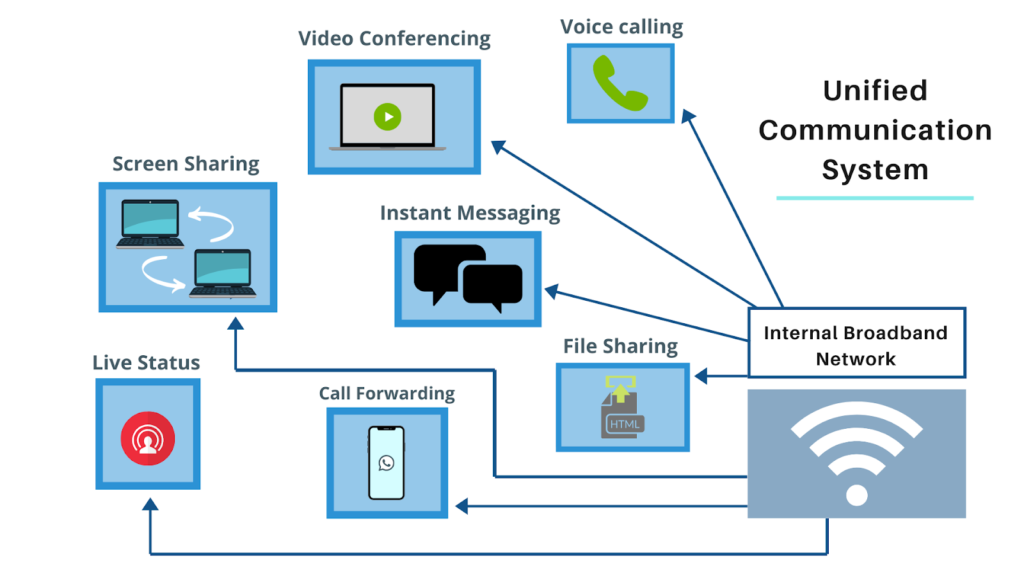Unified Communications (UC) represents a pivotal evolution in modern business communication strategies, seamlessly integrating voice, video, and messaging into cohesive platforms that enhance collaboration and productivity. In today’s interconnected digital landscape, UC solutions serve as robust frameworks, consolidating various communication channels into unified interfaces accessible across devices and locations.

The Integration of Voice, Video, and Messaging
At the heart of Unified Communications lies its ability to unify traditionally disparate communication tools. Voice communication, once confined to desk phones, has transcended into versatile VoIP (Voice over Internet Protocol) systems. These systems leverage the internet to enable voice calls, conferencing, and even voice messages, ensuring seamless connectivity regardless of geographical boundaries.
Video communication, a cornerstone of modern business interactions, has similarly evolved. UC platforms integrate high-definition video conferencing capabilities, allowing face-to-face interactions that foster more engaging and efficient meetings. From team huddles to client presentations, video conferencing enhances communication clarity and interpersonal connection, significantly reducing the limitations imposed by physical distance.
Messaging within UC completes the triad of integrated communication tools. Instant messaging (IM) and chat functionalities provide real-time, asynchronous communication channels that supplement voice and video interactions. These tools facilitate quick exchanges, document sharing, and collaborative discussions, empowering teams to maintain fluid communication throughout the workday.
Enhancing Collaboration and Productivity
The integration of voice, video, and messaging into a unified platform offers substantial benefits to organizations striving for enhanced collaboration and productivity:
- Streamlined Communication: UC eliminates the inefficiencies of managing multiple communication channels by consolidating them into a single, intuitive interface. This streamlines communication workflows, reducing delays and enhancing responsiveness.
- Improved Accessibility: Employees can access UC platforms from various devices—desktops, laptops, smartphones, and tablets—ensuring continuous connectivity whether in the office, at home, or on the go. This flexibility accommodates modern work trends such as remote work and global teams.
- Cost Efficiency: By consolidating communication tools, UC solutions often lead to cost savings. Organizations can minimize expenses associated with maintaining separate systems while leveraging scalable, subscription-based models for their communication needs.
- Enhanced Collaboration: UC fosters collaboration through features like screen sharing, virtual whiteboards, and integrated document editing. These tools empower teams to work together in real time, accelerating decision-making processes and project timelines.
- Scalability and Integration: As businesses grow, UC platforms can scale to accommodate additional users and functionalities seamlessly. Furthermore, UC systems integrate with existing business applications—such as CRM (Customer Relationship Management) and ERP (Enterprise Resource Planning)—enhancing operational efficiency and data accessibility.
Future Trends and Considerations

Looking ahead, the future of Unified Communications promises further innovation. Technologies such as artificial intelligence (AI) and machine learning are poised to enhance UC platforms with predictive analytics, automated workflows, and enhanced user experiences. Additionally, the integration of IoT (Internet of Things) devices and augmented reality (AR) into UC ecosystems holds potential for transforming how teams collaborate and communicate.
In conclusion, Unified Communications represents a transformative approach to modernizing business communications. By integrating voice, video, and messaging into unified platforms, organizations can foster collaboration, increase productivity, and adapt to evolving work environments seamlessly. As businesses navigate digital transformation, embracing UC not only enhances communication but also positions them competitively in an increasingly connected world.



